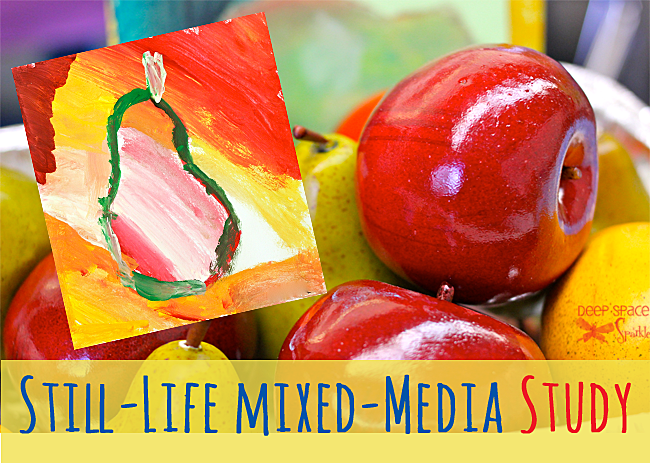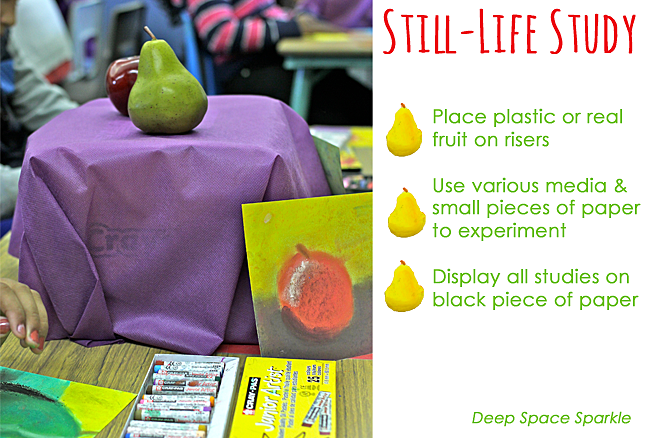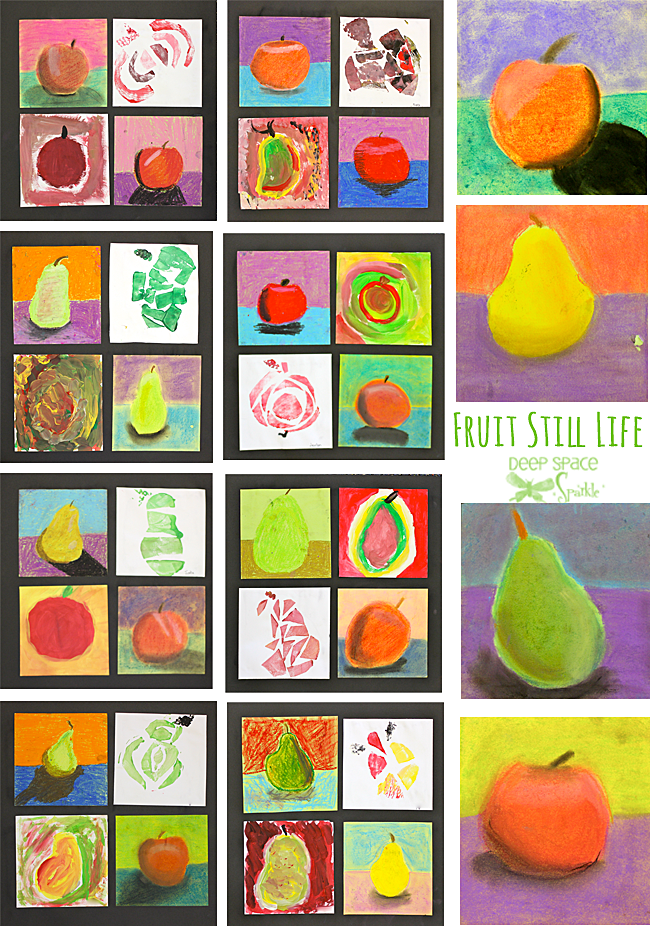Need a lesson where each component takes less than 15 minutes? Consider adding a mixed-media still life study to your art curriculum. I opt to teach this still-life study to older children (grades 4-6 or ages 10-12) as part of our fine arts unit and instead of only using one medium, I mix it up and allow children to create as many as four still-life studies with 4 different techniques.
These are the techniques we used on 6″ x 6″ paper squares
- Chalk Pastel
- Oil Pastels
- Collagraph printmaking
- Tempera paints
Set-Up
Use art supply boxes for risers and cover with fabric or paper. Set one box on each table so all children can view the fruit. Give each child a 6″ x 6″ square of sulphite/construction paper.
Oil Pastel Study
Set a tray or trays of oil pastels on each table (I like to set two trays per table. I have 6 tables). Children draw the fruit (apple or pear) and create a table line. I give little direction for this study with the exception of encouraging the children to keep the drawing large so that they can color in easily. We looked a samples of Van Gogh’s work and I suggested that they could use a similar technique to create their fruit.
Chalk Pastel Study Inspired by Cezanne
Chalk is a natural medium for creating a still-life. The colors are easy to blend and they are easy to control for a small piece of paper. Point out the areas of the apple or pear that receives the most light and the ares that receive the least light. Using dark and light pastels, have the children add the contrasts where they see it. Don’t forget to add shadows along the table top. To make the project challenging, remove all black chalk from the trays and ask the children to use complimentary colors for creating the dark areas.
Collagraph Printing inspired by Cubism
Give each child a 6″ x 6″ cardboard square (I used corrugated cardboard) and a tray of foam craft sheets. Discuss abstraction and cubism with your students and ask them to craete an abstract pear or apple with their foam pieces. Here’s how:
- cut foam pieces into small triangles, squares and other shapes
- glue small pieces onto cardboard
- Once pieces are dry, use thick tempera paint (or acrylic) and a flat paint brush to apply paint onto foam surface
- Press painted side down onto white paper
Tempera Paint Study inspired by Expressionism
My students are most familiar with tempera paints as we use them all of the time. If you would ike, you could try watercolor paints instead. The beauty of the tempera paints is that it is more forgiving than watercolor paints. The children can draw with an oil pastel or a pencil and paint the fruit in whatever style they choose. I encourage them to be expressive with their colors. Many did but some chose to go the realistic route.















This is a wonderful idea Patty. It allows the children to be able to express well having to try 4 different techniques. And it would also allow them to see where they are best at, or at most master those techniques especially to kids who are really into arts.
Cheers,
Stan
Wonderful idea:) I love doing still lives with kids, and multimedia projects:) thanks, for the great ideas!
laurel
I will see you at the CAEA Conference! Looking forward to meeting you. 🙂
Great! Can’t wait to meet you, too!
I love this project! Thanks for sharing your great ideas and tips. Last year I utilized your blog constantly as a volunteer art Mom!
How do you structure the timing of this great lesson?
http://emilyvalenza.tumblr.com/post/66396766668/this-lesson-from-deep-space-sparkle-really
this lesson worked so well for my students- thanks for the inspiration!!
Emily
I love the idea of a series and using different mediums, so I tried it and emphasized shadow and light for my 4th grade students and when they filled out their self assessment it was unanimous that they all loved it, they enjoyed using different techniques and challenging themselves with materials that they were not necessarily most comfortable with. I especially loved the collagraph print and the students reaction to abstraction. Thank You!
Patty Palmer, I like your lesson “Fruit Study Art Lesson ”
thanks.
R.M.Solanki
Art Teacher
Kendriya Vidyalaya ( Space Application Center ), Ahmedabad Gujarat (India)
LOVE this concept and getting ready to try something similar with my 6th graders… How did you handle allowing glued foam pieces to dry before printing? Did you have them come back to it later that same class, or wait until the next class? As always, thank you so much for being such an incredible source of ideas and sharing your talent!
I love this lesson, and have used the concepts and examples, but changed the subject matter to cups of paint brushes. My greatest challenge is time as I have half hour periods. I started having the students use youtube videos plus my demonstrations to learn techniques with each media, but due to time had them employ the techniques directly on their drawings of the brushes. The results are impressive yet as with all projects with half hour classes having students using different medias at different rates is all exhausting with one adult and basically twenty minutes to work at most. Thank you for the inspiration!
I love this! I have mixed grade classes- 4 tables. I plan to set up one technique at each table then have students rotate through “stations” so everyone is working all the time. Great for this time of year too when there are so many fun fall fruits and veggies! Can’t wait to try it!